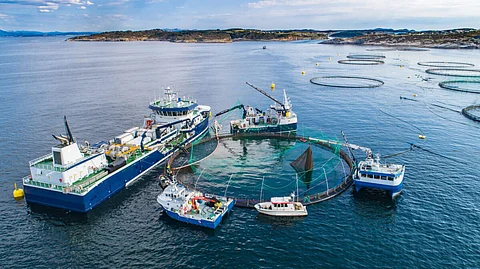

When it comes to aquaculture, beyond production, there is a network of suppliers that are also essential for the chain to continue functioning. Aware of this, Kontali, an independent world-leading provider of data and analyses covering large parts of global aquaculture and fisheries, publishes each year the Norwegian Aquaculture Supplier Report. We spoke to one of its analysts, Arild Stormer about the highlights of the latest edition, 2022.
An emerging trend
According to Arild, it appears that a trend is beginning to emerge. While there are variations among companies, a general trend towards consolidation within the supplier industry is becoming evident. Many companies are seeking economies of scale and greater access to a broader range of services and larger portfolio, resulting in a rise in mergers and acquisitions.
This is something that is happening especially in the wellboat segment and Stormer gives us an example with Åkerblå. The leader in knowledge-based marine health company has been acquiring smaller firms in recent years.
Stormer explains that, as the trend towards more and more mergers becomes evident, we see that there is also innovation within the industry that contributes to increased competition. However, this also means that entering the market and gaining market share is becoming increasingly capital-intensive.
"Generally speaking, the wellboat segment has extremely good profit margins and has had them for several years. Over time, they have received more assignments and have become a bigger part of daily operations. They not only deliver fish, but also have a greater role in delousing (thermally and mechanically), which accounts for approximately NOK 7 billion annually", he says.
The fact is that the sales revenue for the wellboat segment has significantly increased by 3.3 billion NOK from 2020, representing a 9% increase in just one year. However, there have been significant variations in activity levels among operators, with five companies reporting negative earnings before interest and taxes (EBIT).
Aquaculture companies have begun building their own wellboats to avoid relying on a shipping company, choosing to build them themselves. As Stormer explains, a company such as Alsaker – one of the leading farming groups in Norway when it comes to salmon production – may say, "When it is so expensive to rent a wellboat, it is better to do the job ourselves."
During his conversation with WeAreAquaculture, Arild Stormer highlights one more thing, a risk for Norwegian aquaculture suppliers: the ground rent tax in Norway. We do not know the full repercussions of this in the long run, he explains. There are already investments worth billions that have been frozen and projects have been halted, precisely due to the tax. Although this primarily impacts those with food fish licenses, it will also affect other collaborating actors in the value chain. This may lead to more focus on the cost side of operations, further increasing pressure and competition among suppliers.
Moreover, the impact of the salmon tax is expected to have significant consequences on the direct supply industry, with investors in hatcheries, and further processing being affected.
In conclusion, while the long-term effects of the rent tax remain uncertain, it is clear that the tax is causing concern across the entire value chain, with larger consequences than initially anticipated. It may take a few years before we fully understand its impact.
Kontali's Norwegian Aquaculture Suppliers 2022 report includes up to 14 different segments of the aquaculture supply chain:
The report is based in various sources, mainly the official financial statements available from The Brønnøysund Register Center, and, although it does not cover all suppliers to the Norwegian aquaculture industry, it does analyse a broad sample of 178 suppliers.
Kontali is an independent world-leading provider of data and analyses covering large parts of global aquaculture and fisheries. Their mission is to acquire a comprehensive understanding of the realm of aquaculture and fisheries, including the various species and their interconnections. By sharing their extensive knowledge of seafood, they aim to promote a more balanced world, both above and below the surface.
